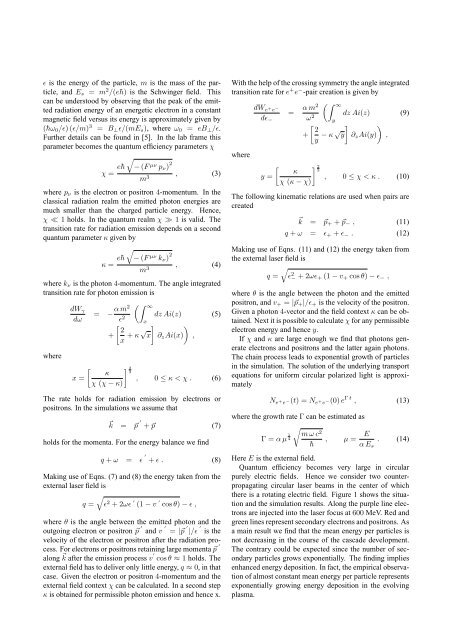Proceedings of International Conference on Physics in ... - KEK
Proceedings of International Conference on Physics in ... - KEK
Proceedings of International Conference on Physics in ... - KEK
You also want an ePaper? Increase the reach of your titles
YUMPU automatically turns print PDFs into web optimized ePapers that Google loves.
ϵ is the energy <str<strong>on</strong>g>of</str<strong>on</strong>g> the particle, m is the mass <str<strong>on</strong>g>of</str<strong>on</strong>g> the particle,<br />
and Es = m2 /(e¯h) is the Schw<strong>in</strong>ger field. This<br />
can be understood by observ<strong>in</strong>g that the peak <str<strong>on</strong>g>of</str<strong>on</strong>g> the emitted<br />
radiati<strong>on</strong> energy <str<strong>on</strong>g>of</str<strong>on</strong>g> an energetic electr<strong>on</strong> <strong>in</strong> a c<strong>on</strong>stant<br />
magnetic field versus its energy is approximately given by<br />
(¯hω0/ϵ) (ϵ/m) 3 = B⊥ϵ/(mEs), where ω0 = eB⊥/ϵ.<br />
Further details can be found <strong>in</strong> [5]. In the lab frame this<br />
parameter becomes the quantum efficiency parameters χ<br />
χ = e¯h<br />
√<br />
− (F µν pν) 2<br />
m3 , (3)<br />
where pν is the electr<strong>on</strong> or positr<strong>on</strong> 4-momentum. In the<br />
classical radiati<strong>on</strong> realm the emitted phot<strong>on</strong> energies are<br />
much smaller than the charged particle energy. Hence,<br />
χ ≪ 1 holds. In the quantum realm χ ≫ 1 is valid. The<br />
transiti<strong>on</strong> rate for radiati<strong>on</strong> emissi<strong>on</strong> depends <strong>on</strong> a sec<strong>on</strong>d<br />
quantum parameter κ given by<br />
κ = e¯h<br />
√<br />
− (F µν kν) 2<br />
m3 , (4)<br />
where kν is the phot<strong>on</strong> 4-momentum. The angle <strong>in</strong>tegrated<br />
transiti<strong>on</strong> rate for phot<strong>on</strong> emissi<strong>on</strong> is<br />
where<br />
dWγ<br />
dω<br />
(∫ ∞<br />
m2<br />
= −α<br />
ϵ2 dz Ai(z) (5)<br />
x<br />
[<br />
2<br />
+<br />
x + κ √ ] )<br />
x ∂zAi(x) ,<br />
[<br />
κ<br />
x =<br />
χ (χ − κ)<br />
] 2<br />
3<br />
, 0 ≤ κ < χ . (6)<br />
The rate holds for radiati<strong>on</strong> emissi<strong>on</strong> by electr<strong>on</strong>s or<br />
positr<strong>on</strong>s. In the simulati<strong>on</strong>s we assume that<br />
′<br />
⃗k = ⃗p + ⃗p (7)<br />
holds for the momenta. For the energy balance we f<strong>in</strong>d<br />
q + ω = ϵ ′<br />
+ ϵ . (8)<br />
Mak<strong>in</strong>g use <str<strong>on</strong>g>of</str<strong>on</strong>g> Eqns. (7) and (8) the energy taken from the<br />
external laser field is<br />
q =<br />
√<br />
ϵ 2 + 2ωϵ ′ (1 − v ′ cos θ) − ϵ ,<br />
where θ is the angle between the emitted phot<strong>on</strong> and the<br />
outgo<strong>in</strong>g electr<strong>on</strong> or positr<strong>on</strong> ⃗p ′<br />
and v ′<br />
= |⃗p ′<br />
|/ϵ ′<br />
is the<br />
velocity <str<strong>on</strong>g>of</str<strong>on</strong>g> the electr<strong>on</strong> or positr<strong>on</strong> after the radiati<strong>on</strong> process.<br />
For electr<strong>on</strong>s or positr<strong>on</strong>s reta<strong>in</strong><strong>in</strong>g large momenta ⃗p ′<br />
al<strong>on</strong>g ⃗k after the emissi<strong>on</strong> process v ′<br />
cos θ ≈ 1 holds. The<br />
external field has to deliver <strong>on</strong>ly little energy, q ≈ 0, <strong>in</strong> that<br />
case. Given the electr<strong>on</strong> or positr<strong>on</strong> 4-momentum and the<br />
external field c<strong>on</strong>text χ can be calculated. In a sec<strong>on</strong>d step<br />
κ is obta<strong>in</strong>ed for permissible phot<strong>on</strong> emissi<strong>on</strong> and hence x.<br />
With the help <str<strong>on</strong>g>of</str<strong>on</strong>g> the cross<strong>in</strong>g symmetry the angle <strong>in</strong>tegrated<br />
transiti<strong>on</strong> rate for e + e−-pair creati<strong>on</strong> is given by<br />
where<br />
dW e + e −<br />
dϵ−<br />
= α m2<br />
ω2 (∫ ∞<br />
y<br />
+<br />
[<br />
κ<br />
y =<br />
χ (κ − χ)<br />
[<br />
2<br />
y − κ √ ]<br />
y<br />
] 2<br />
3<br />
dz Ai(z) (9)<br />
)<br />
∂zAi(y) ,<br />
, 0 ≤ χ < κ . (10)<br />
The follow<strong>in</strong>g k<strong>in</strong>ematic relati<strong>on</strong>s are used when pairs are<br />
created<br />
⃗ k = ⃗p+ + ⃗p− , (11)<br />
q + ω = ϵ+ + ϵ− . (12)<br />
Mak<strong>in</strong>g use <str<strong>on</strong>g>of</str<strong>on</strong>g> Eqns. (11) and (12) the energy taken from<br />
the external laser field is<br />
√<br />
q = ϵ2 − + 2ωϵ+ (1 − v+ cos θ) − ϵ− ,<br />
where θ is the angle between the phot<strong>on</strong> and the emitted<br />
positr<strong>on</strong>, and v+ = |⃗p+|/ϵ+ is the velocity <str<strong>on</strong>g>of</str<strong>on</strong>g> the positr<strong>on</strong>.<br />
Given a phot<strong>on</strong> 4-vector and the field c<strong>on</strong>text κ can be obta<strong>in</strong>ed.<br />
Next it is possible to calculate χ for any permissible<br />
electr<strong>on</strong> energy and hence y.<br />
If χ and κ are large enough we f<strong>in</strong>d that phot<strong>on</strong>s generate<br />
electr<strong>on</strong>s and positr<strong>on</strong>s and the latter aga<strong>in</strong> phot<strong>on</strong>s.<br />
The cha<strong>in</strong> process leads to exp<strong>on</strong>ential growth <str<strong>on</strong>g>of</str<strong>on</strong>g> particles<br />
<strong>in</strong> the simulati<strong>on</strong>. The soluti<strong>on</strong> <str<strong>on</strong>g>of</str<strong>on</strong>g> the underly<strong>in</strong>g transport<br />
equati<strong>on</strong>s for uniform circular polarized light is approximately<br />
N e + e −(t) = N e + e −(0) e Γ t , (13)<br />
where the growth rate Γ can be estimated as<br />
Γ = α µ 1<br />
√<br />
m ω c2 4 ,<br />
¯h<br />
µ = E<br />
.<br />
α Es<br />
(14)<br />
Here E is the external field.<br />
Quantum efficiency becomes very large <strong>in</strong> circular<br />
purely electric fields. Hence we c<strong>on</strong>sider two counterpropagat<strong>in</strong>g<br />
circular laser beams <strong>in</strong> the center <str<strong>on</strong>g>of</str<strong>on</strong>g> which<br />
there is a rotat<strong>in</strong>g electric field. Figure 1 shows the situati<strong>on</strong><br />
and the simulati<strong>on</strong> results. Al<strong>on</strong>g the purple l<strong>in</strong>e electr<strong>on</strong>s<br />
are <strong>in</strong>jected <strong>in</strong>to the laser focus at 600 MeV. Red and<br />
green l<strong>in</strong>es represent sec<strong>on</strong>dary electr<strong>on</strong>s and positr<strong>on</strong>s. As<br />
a ma<strong>in</strong> result we f<strong>in</strong>d that the mean energy per particles is<br />
not decreas<strong>in</strong>g <strong>in</strong> the course <str<strong>on</strong>g>of</str<strong>on</strong>g> the cascade development.<br />
The c<strong>on</strong>trary could be expected s<strong>in</strong>ce the number <str<strong>on</strong>g>of</str<strong>on</strong>g> sec<strong>on</strong>dary<br />
particles grows exp<strong>on</strong>entially. The f<strong>in</strong>d<strong>in</strong>g implies<br />
enhanced energy depositi<strong>on</strong>. In fact, the empirical observati<strong>on</strong><br />
<str<strong>on</strong>g>of</str<strong>on</strong>g> almost c<strong>on</strong>stant mean energy per particle represents<br />
exp<strong>on</strong>entially grow<strong>in</strong>g energy depositi<strong>on</strong> <strong>in</strong> the evolv<strong>in</strong>g<br />
plasma.













